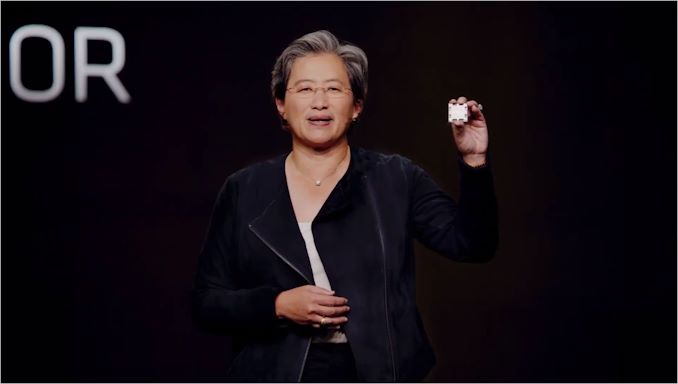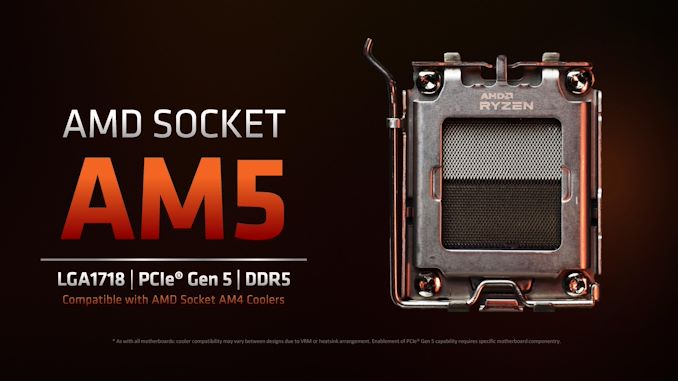CES 2022: AMD’s Next-Gen AM5 Platform to Have Long Term Support
by Dr. Ian Cutress on January 7, 2022 9:00 AM EST- Posted in
- CPUs
- AMD
- Trade Shows
- AM4
- Lisa Su
- Zen 4
- CES 2022
- AM5
- Ryzen 7000

One of the key aspects of AMD’s offering in the consumer desktop space is the longevity of its socket and platform. Throughout the years, AMD has leveraged a single socket for multiple generations, providing users the ability to keep the same motherboard year in and year out, while the competition changes the socket every couple of generations at best. To keep that mantra, AMD has stated that its next-generation platform coming later this year, AM5, will also be a multi-generational platform.
Going back in AMD’s history we can see just how long various platforms have lasted, from first processor launch to last processor launch:
- Socket 939 from 2004 to 2006
- AM2/2+ socket from 2006 to 2009
- AM3/3+ socket from 2009 to 2013
- FM2/2+ socket from 2012 to 2015
- AM4 socket from 2016 to 2021
- AM5 socket from 2021 to ...
Within that time there have been chipset updates to allow for better IO, however usually the socket change has happened because of DDR version changes, interconnect, and PCIe. In this instance, the move from AM4 to AM5 comes with a change from DDR4 to DDR5 and PCIe 4.0 to PCIe 5.0.
In a roundtable with Dr. Lisa Su, the question was asked about how long AM5 would be around – now that AMD has a sustainable position again in the desktop, and by many measures a leading position, would AMD continue its tradition of longer-lived desktop platforms. Dr. Su stated that AM4 ‘has been good for the community and … it’s been good for us as well’. She confirmed that a change was required with the new standards, but on strategy it was put that ‘I don’t have an exact number of years but I would say that you should expect that AM5 will be a long-lived platform as AM4 has been’. Dr. Su also stated that even with the introduction of AM5, the company expects AM4 to stay in the marketplace for some years, with overlap between the two depending on the market.
For users wondering how far AM5 can go before it needs to change again, it’s worth looking at roadmaps for the two usual elements that cause socket updates: memory and PCIe. We’re only just on the transition to DDR5, and DDR6 is a long way away – in a recent Samsung presentation, for example, it listed DDR6 as a 2028 technology. Similarly with PCIe 5.0, the same presentation puts PCIe 6.0 as a 2026 technology, and PCIe 7.0 as a 2029 technology. So unless AMD wants to increase the pin count on the CPUs for more memory channels or more PCIe lanes, the PCIe 5.0+DDR5 combination looks set until at least 2026.











42 Comments
View All Comments
trenzterra - Friday, January 7, 2022 - link
Glad someone mentioned this. I got one of those in early 2005 just to save some pennies and I regretted the next year when I realised how limited my upgrade options were. Even getting a PCIE mobo was next to impossible and was stuck on AGP longer than I liked.GeoffreyA - Friday, January 7, 2022 - link
No dual-channel memory, and if I remember rightly, the 3700+ was the highest CPU it could take.dwillmore - Sunday, January 9, 2022 - link
3400+ IIRC. The 3700 was a mobile part. And this article is about desktop sockets (or else they're missing a while bunch more sockets from AMD).dwillmore - Sunday, January 9, 2022 - link
I have one in the basement. Should still run. I wonder if I got one of the 64 bit capable ones? I honesty don't remember. I bought it from CompUSA if that gives you any idea of how old it is. :) Has SATA-1 ports, IIRC.GeoffreyA - Monday, January 10, 2022 - link
I think all Socket 754 CPUs were x64.dwillmore - Monday, January 10, 2022 - link
No, only the E6 stepping on the 90mm parts according to wikipedia at least.artk2219 - Sunday, January 9, 2022 - link
To be fair they started their list on socket 939, they could have gone back to super socket 7 if they wanted (supported everything from pentium mmx through k6 III+, awesome chip options), doesn't mean slot a, and socket 754 users didn't get burned in the interim though.dwillmore - Sunday, January 9, 2022 - link
They left out Socket A as well, which was also clearly an AMD socket. :)artk2219 - Sunday, January 9, 2022 - link
Yep, but socket a atleast was well supported for a few generations, from thunderbird 600's to XP 3200+'s. My favorite board from that generation would have to be Soyo's kt600 dragon ultra platinum, it was stable and while not the fastest looked super neat, there were several great nforce2 boards available.GeoffreyA - Monday, January 10, 2022 - link
My heart was set on the MSI nForce2 motherboard and XP 3200+, but I ended up with a Chaintech VNF3-250 and Athlon 64 3000+. Unfortunately, that computer gave me endless trouble, owing to a cheapline PSU.From there, I went to a second-hand Pentium 4 Willamette, 1.7 GHz, that ran flawlessly for a decade. I've still got it with my old installation of XP and sometimes boot it up to test things.